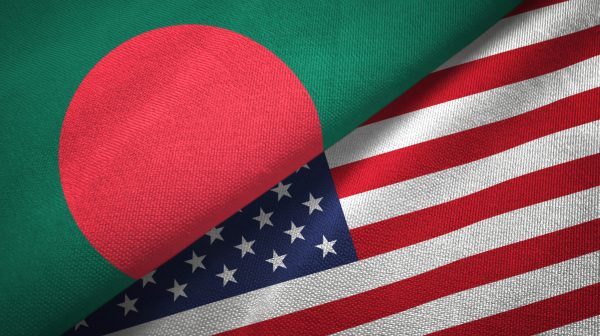About 37 kilometres off the shore of Bangladesh lies a remote island in the Bay of Bengal. For years the island was only used by the Bangladesh navy as it has long been viewed as dangerous to inhabitants.
But in recent years, the island of Bhasan Char has become home to some 30,000 Rohingya refugees who fled a genocide in Myanmar in 2017. Lured to relocate to the island by the Bangladesh authorities, it’s now an ominous place shrouded in controversy and fear, earning itself an unenviable nickname – ‘The Prison Island.”
In over a dozen interviews with refugees living on Bhasan Char, refugees described various insecurities: a place with few jobs, lack of freedom of movement, and limited access to healthcare. Yet one fundamental grievance stood out during the interviews – refugees fear they may never be allowed to leave.
Gazing out into the open compound, Monoara Begum, a 53-year-old Rohingya refugee living on the island sits on the front porch of her 24-square-foot shelter to pass the time. Housed in a row of white apartment blocks with bright red tiled roofing, the area structurally resembles a prison.

“It is a promise-breaking island. I made a mistake coming here,” Begum told the Globe. “We can’t go anywhere from this island. My husband is also getting old, and both of us are getting old age diseases, but we can’t get good treatment.
She shares the small space with her daughter and husband who have both become increasingly depressed since they arrived on the island in 2020.
The Rohingya, a predominantly muslim minority group from Myanmar, have been persecuted by the Myanmar military and nationalists for decades. Violence spiked after a Rohingya armed group attacked a police outpost in 2017, sparking a mass exodus when the military began burning down their villages in Rakhine State.
Over 740,000 Rohingya fled to Bangladesh in August 2017 after the Myanmar military carried out ‘clearance operations’ killing thousands of Rohingya people.

The refugees initially agreed to move to Bhasan Char under the promise of improved living conditions, ability to work, and safety from increasing attacks by armed insurgent groups in the mainland camps in Bangladesh’s Cox’s Bazar.
Officials claim they resettled the refugees, of whom 80% are women and children, to make more space in the original camps where almost 1 million Rohingya refugees currently live in extremely poor conditions. Bangladesh is planning to resettle at least 100,000 refugees in total.
Yet human rights groups are concerned that the island settlement isn’t adequately protected from storms and flooding. They also fear that worsening monsoons could eventually devastate the island, leaving those left behind stranded and in peril. On top of this, the prospect of food insecurity and a lack of schools and healthcare makes the island a difficult place to live, refugees told the Globe.

Access to and from Bhasan Char is tightly controlled by the Bangladesh navy and coast guard. The island is walled off with barbed wire fencing, and it’s illegal to enter without the correct permits. These restrictions make visitations from families increasingly difficult. Yet hundreds have already left the island in search of better lives. But leaving often comes at cost.
In recent months, dozens have been arrested in nearby coastal towns after being discovered by law enforcement. Others risk death when smuggled out on rickety fishing boats during the four to six hour journey needed to reach mainland Bangladesh.
One harrowing case occurred in August 2021, when a group of 41 Rohingya attempted to flee the island on a fishing trawler. But when a storm hit the boat, the vessel capsized leaving 14 people dead and 13 missing.
According to local police who spoke to the Globe, over two hundred refugees have fled the island in the last two years. Authorities have arrested 55 people, including women and children, and have repeatedly sent them back. For human rights groups, the fact that refugees are taking extreme efforts to escape the island reflects the excruciating conditions they face.

“In terms of the vulnerabilities, there are restrictions on freedom of movement within the island itself, and there is no access to livelihood and access to education,” said Zaw Win, from Fortify Rights, a human rights group working in Asia. “There are also gender based violence cases happening on the island.”
Zaw Win went into detail about restrictions of movement, detailing that when refugees move to Bhasan Char, they are not able to come back and visit the mainland camp to see their families. As authorities arrange transport to and from the island, the refugees have very little control over their ability to move.
Despite the refugees’ statements and observations by rights groups, Mohammad Mahfuzur Rahman, the government’s Refugee Relief and Repatriation Commissioner told the Globe that the authorities are doing everything they can to help.

“We arrange for Rohingyas to visit their relatives in Cox’s Bazar or their relatives in Bhasan Char once a month,” Rahman said. “We are trying to arrange this twice a month. A lot has to do with visiting their relatives. We have to arrange a ship, bus, and other security. “Rahman added that authorities are attempting to provide more medical aid and transportation, but are “waiting on donations first.” It’s unclear how many refugees desire to leave Bhasan Char today, but based on Globe’s interviews, being kept away from their families is one of the main motivators.
“We don’t feel very good if they don’t allow us to visit our relatives,” said Abdul Hamid, a 30-year-old refugee on Bhasan Char. “I want to leave here, but where to go, there is nowhere to go.”
Another refugee, Shiraj Mia, has been trying to get back to Chittagong, a southeastern coastal town, for over three months. Suffering from severe heart disease, doctors told him that he needs better treatment or risk heart attacks or worse. Given his health, he simply wants to be with his relatives in Cox’s Bazar.

“I could die at any time [from his illness]. We can’t go anywhere from here,” he said. “If I was in Cox’s Bazar,I could visit my relatives…Before coming here, they told us that I could go to Cox’s Bazar whenever I wanted. But that is not allowed.”
In response to the refugee’s concerns, UNHCR has set up “protection networks,” where refugee volunteers have been trained to recognise needs in their own communities and offer help, including child protection, prevention of gender-based violence, and mental health assistance, Regina De La Portilla, a UNHCR communication officer in Cox’s Bazar, told the Globe.
“This being said, there are still many challenges ahead. We need more funding to enhance activities on the island, including health and mental health, but also livelihood activities and education,” De La Portilla said.
Additionally, she mentions, the government-led project’s sustainability relies on improving connectivity between the island and the mainland – as is the case of other islands.
While the government has been facilitating family visits, the connectivity with the mainland needs to be enhanced and scaled up so individuals have regular travel opportunities to visit Cox’s Bazar to help ensure family unity.”
Despite these acknowledgements, refugees say the island is no place for the sick given medical facilities are limited and medication is expensive. It’s a concern too familiar with Menorah Begum as well. About six months after arriving on the island, her son died due to a mysterious illness.
When she asked officials for help with medical treatment, they told her to wait. But by the time her son was permitted to leave to receive medical attention, it was already too late. He passed away shortly after. Begum hopes the same thing won’t happen to others like her and prays for a better future for her family.
“I live a captive life here,” she said with tears rolling down her face. “The whole island is a prison. [And] there is no cure, there is no ray of hope. [On Bhasan Char] I am destitute.”
Photos by Tanbirul Miraj Ripon for Southeast Asia Globe.





















Discussion about this post